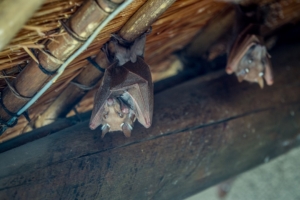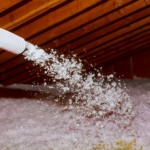What Attracts Bats To Your Attic?
Bats are flying mammals that prefer to live in cozy, dry, warm, and sheltered locations. Moreover, because of their nocturnal nature, they favor dark places where they can roost, hibernate, and raise their young. Taking these conditions into account, the attic turns out to be an ideal place to stay for most bat species. The attic offers a more suitable shelter than anywhere else, so if a bat finds its way in, it’s likely to set up camp there.
If you want to keep your home safe from these unwanted visitors, keep reading to find out what could be attracting bats to your attic.
What Draws Bats To Your Attic?
Bats, just like any other wild animal or pest, choose to inhabit human properties for these three main reasons: food, water, and shelter.
They will seek nesting locations that are close to sources of food and water. If they have chosen your attic as their roosting spot, it is likely because they have discovered that your home is a great food source.
You might think that bats are attracted to light, but that’s not true. These animals are only interested in insects that swarm around lights in the dark. Night-flying insects such as mosquitoes and moths, along with termites, beetles, stinkbugs, worms, spiders, and cockroaches are an excellent source of food for bats. A single bat can consume as many as 3,000 bugs every night!
Indoor temperatures also play a significant role in attracting bats. Like many other kinds of invasive wildlife, bats often find their way into homes looking for warmth and shelter. They are attracted to the heat and dryness of your attic and the shelter it provides, especially as winter approaches. The nesting site must be warm enough for them. Bats look for high temperatures, which means the heat of the attic is very suitable. When the cold weather sets in, the cracks and crevices could lead them straight into your cozy, warm attic space.
Most bats will start looking for a place to hibernate from September, and the warm indoor environment of your attic is exactly what they need in order to survive the cold winter season.
In the summer months, on the other hand, bats are the most active as this is their maternity season. They roost in hot attics since the space serves as an incubator for their newborn babies. The pups have no fur, which means that they are unable to keep themselves warm, without their mother. So the females leave their young in the dark and hot place, and go hunting for food. This place happens to be your attic.
Bats also prefer to choose dry and dark areas as their nesting sites. They tend to live in large colonies and love to be in dark places.
Bats often get into your attic because they’re searching for shelter from the weather outside, or they want to be protected from predators. Sometimes they’re just lost and found an entrance into your home.
As attics are located high from the ground, they make an ideal roosting spot for flight clearance.
In addition, some bat species have the habit of nesting in trees, therefore they might be attracted to wood framing in your attic.

How Are Bats Getting In Your Attic?
Many homeowners don’t even realize there are bats living in their attic. This wildlife tends to be really sneaky in the way they enter your property. They find small gaps and cracks, and once inside, they build their nest in your attic.
Bats often enter inside by squeezing between damaged or rotting shingles. They are able to squeeze their way into surprisingly tiny holes or even push through rotten wood to create their own openings. A hole as small as a half to a quarter inch is enough for them to get in. So check for any damaged, cracked, peeled, or missing shingles on your roof.
Bats can also get into your attic by chimneys or broken vents. Therefore, it is important to regularly inspect for signs of bats in your home. Make sure there are no droppings or damage to your insulation or wiring which could indicate a bat presence. If you see one bat, it could mean that more are nearby.
Are Bats In The Attic Dangerous?
Bats are known to carry diseases, and some are infected with rabies. However, in reality, there is only a small chance that a bat could come after you and bite you.
It’s more likely that these animals cause damage to insulation, wiring, and other features in the attic, being a threat to the structural integrity of your home.
Bats also produce a large amount of droppings that can attract other pests to your attic. Their feces cause stains and can be a breeding ground for bacteria, mold, and mildew. This will cause the air in your home to become contaminated.
If you don’t check your attic space on a regular basis, you could find yourself hosting bats over the winter season or even all year round. Getting rid of bats from your attic is a complicated and unique task, which is why you will always need to contact a professional to deal with the problem.
The expert will remove these animals from your attic and help avoid costly damage. Call Pest Control Authority Wildlife to schedule an inspection of your attic and home at the first sign of trouble. We are ready to help!





